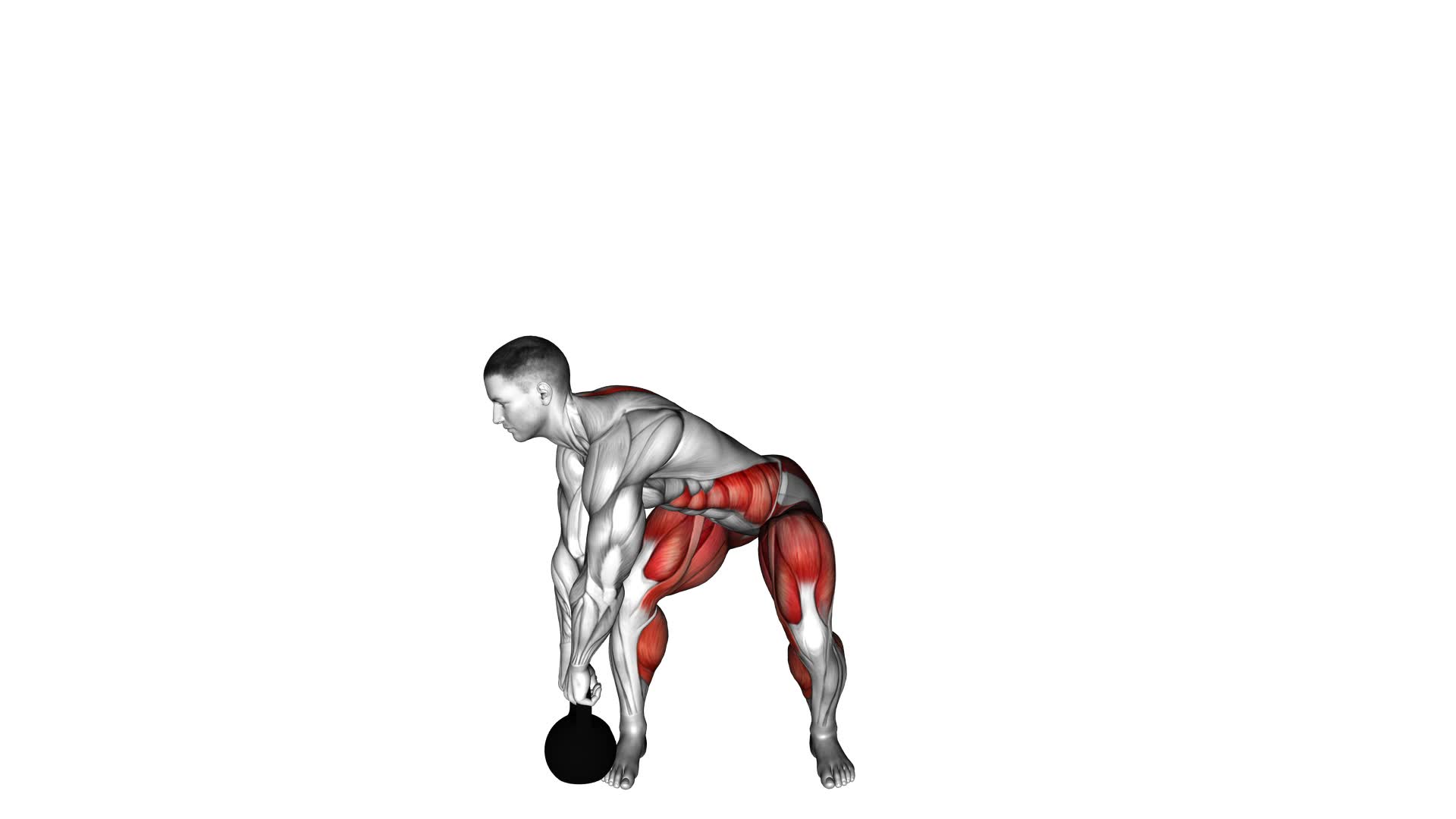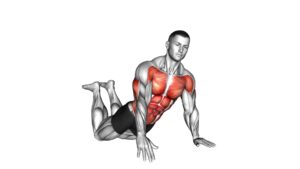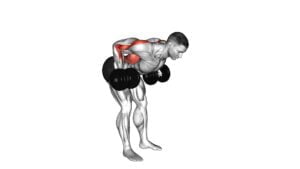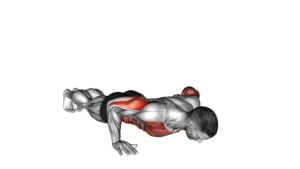Kettlebell Rotational Deadlift (male) – Video Exercise Guide & Tips

Are you looking to level up your strength training routine? Then the Kettlebell Rotational Deadlift is the perfect exercise for you. This dynamic movement targets multiple muscle groups, helping you build a strong and stable core.
Watch This Exercise Video
In this video exercise guide, we'll walk you through the proper form and technique, provide essential tips for execution, and offer modifications for different fitness levels.
Get ready to take your fitness to the next level with this challenging yet rewarding exercise.
Key Takeaways
- The Kettlebell Rotational Deadlift improves core strength and hip mobility.
- It engages various abdominal muscles and stabilizes the spine.
- Proper form and technique are essential to avoid rounding the back and fully engage the hip muscles.
- Modifications can be made for different fitness levels, such as using lighter weights for beginners and heavier weights for advanced individuals.
Benefits of the Kettlebell Rotational Deadlift
The Kettlebell Rotational Deadlift offers a multitude of benefits for your overall strength and core stability. This exercise is highly effective in improving core strength and increasing hip mobility.
By incorporating rotational movement patterns, the Kettlebell Rotational Deadlift engages the muscles of your core, including the rectus abdominis, obliques, and transverse abdominis. These muscles work together to stabilize your spine and maintain proper posture during the exercise.
In addition to improving core strength, the Kettlebell Rotational Deadlift also helps to increase hip mobility. As you rotate your body while performing the exercise, your hip joints are required to move through a greater range of motion. This helps to improve flexibility and mobility in the hips, which can be beneficial for various activities and sports that require twisting or turning movements.
By regularly incorporating the Kettlebell Rotational Deadlift into your workout routine, you can expect to see improvements in your overall strength, core stability, and hip mobility. This exercise not only targets specific muscle groups but also challenges your body to work in a functional and coordinated manner.
Proper Form and Technique
To perform the Kettlebell Rotational Deadlift with proper form and technique, you should focus on maintaining a stable core and engaging your hip muscles throughout the exercise. This will ensure that you maximize the benefits of the movement and reduce the risk of injury.
One of the most common errors in this exercise is rounding the back. To avoid this, make sure to keep your spine neutral and your chest lifted throughout the entire movement. This will help you maintain proper alignment and protect your lower back.
Another common error isn't fully engaging the hip muscles. To target the correct muscle groups, focus on driving your hips forward as you come up from the deadlift position. This will activate your glutes and hamstrings, giving you a more effective workout.
By maintaining a stable core and engaging your hip muscles, you'll target the muscles in your lower body, including the glutes, hamstrings, quadriceps, and calves. Additionally, this exercise also engages your core muscles, including the abs and obliques, as well as the muscles in your back.
Remember to start with a lighter kettlebell to ensure proper form and technique before progressing to a heavier weight. With practice and attention to detail, you can perform the Kettlebell Rotational Deadlift with precision and reap the full benefits of this exercise.
Essential Tips for Proper Execution
To ensure proper execution of the Kettlebell Rotational Deadlift, it's important that you engage your core and hip muscles while maintaining a stable spine. This exercise primarily targets your glutes, hamstrings, quadriceps, and core muscles.
To perform the exercise correctly, start by standing with your feet shoulder-width apart and the kettlebell placed between your feet. Bend your knees and hinge at the hips to grab the kettlebell with both hands, keeping your back straight and chest up. As you lift the kettlebell, exhale and engage your core by pulling your belly button towards your spine. Keep your shoulders down and back throughout the movement.
To maintain proper form, a common cue is to imagine that you're pushing your hips back and down, similar to sitting in a chair. This helps to engage your glutes and hamstrings while keeping your spine neutral. Another cue is to imagine driving your feet into the ground as you stand up, using the power from your hips and legs to lift the kettlebell.
Remember to keep your core engaged and avoid rounding your back or letting your shoulders roll forward. By following these tips and cues, you can ensure proper execution of the Kettlebell Rotational Deadlift and maximize the benefits for your targeted muscle groups.
Modifications for Different Fitness Levels
For individuals at different fitness levels, modifying the Kettlebell Rotational Deadlift can be done by adjusting the weight used and the range of motion. Here are some scaling options and progression variations to consider:
- Scaling options:
- Beginners: Start with a lighter kettlebell or even a dumbbell. This will allow you to focus on proper form and technique before progressing to heavier weights.
- Intermediate: Increase the weight gradually as you build strength and confidence. You can also try using a kettlebell with a thicker handle to further challenge your grip.
- Advanced: Use a heavier kettlebell or even two kettlebells for added resistance. This will increase the difficulty and intensity of the exercise.
- Progression variations:
- Narrow stance: Place your feet closer together to increase stability and engage your core muscles even more.
- Greater range of motion: Lower the kettlebell closer to the ground, increasing the challenge on your hamstrings and glutes.
- Single-arm deadlift: Perform the exercise with one hand at a time, focusing on stability and control.
Common Mistakes to Avoid
Avoiding common mistakes is crucial for maximizing the effectiveness of the Kettlebell Rotational Deadlift and ensuring optimal results. By avoiding these mistakes, you can perform the exercise correctly and reduce the risk of injury.
One common mistake is rounding the back during the movement. It's important to keep your back straight and engage your core muscles to maintain proper form.
Another mistake is using too heavy of a kettlebell. This can lead to improper technique and strain on your muscles. Start with a lighter weight and gradually increase as you become more comfortable and confident with the exercise.
Additionally, rushing through the movement is a common mistake. Take your time and focus on each repetition, ensuring proper form and technique.
Lastly, avoid using momentum to lift the kettlebell. The movement should be controlled and driven by your hips and legs, rather than relying on swinging or jerking motions.
Frequently Asked Questions
How Many Sets and Reps Should I Do for the Kettlebell Rotational Deadlift?
To determine the number of sets and reps for the kettlebell rotational deadlift, consider the benefits of rotational exercises. Rotational movements engage multiple muscle groups, improve core strength, and enhance overall stability.
Variations of the kettlebell rotational deadlift can include changing the weight, tempo, or adding a twist at the top of the movement.
Consult a fitness professional or trainer to create a personalized workout plan that suits your fitness level and goals.
Can I Substitute the Kettlebell With a Dumbbell or Barbell for This Exercise?
Yes, you can substitute the kettlebell with a dumbbell or a barbell for the rotational deadlift exercise. This allows for variation in equipment based on your personal preference or availability.
Just make sure to maintain proper form and technique. Additionally, you can modify the exercise to suit different fitness levels by adjusting the weight or using a lighter resistance.
Always listen to your body and choose the appropriate modifications that challenge you without compromising safety.
Is It Necessary to Warm up Before Performing the Kettlebell Rotational Deadlift?
Yes, it's necessary to warm up before performing the kettlebell rotational deadlift. Warming up has many benefits, such as increasing blood flow to your muscles, improving flexibility, and reducing the risk of injury.
Before starting the exercise, make sure to focus on proper form and technique. Keep your back straight, engage your core, and use your hips and legs to lift the kettlebell.
This will help you maximize the effectiveness of the exercise and avoid any potential strain or injury.
Can the Kettlebell Rotational Deadlift Help With Improving Core Strength?
The kettlebell rotational deadlift is a great exercise for improving core strength. By incorporating rotational movements, this exercise targets the muscles in your core and helps to improve balance. It engages your abs, obliques, and lower back, providing a comprehensive workout for your core muscles.
Not only does this exercise help to strengthen your core, but it also has the added benefits of improving balance and promoting better overall stability.
What Are Some Other Exercises That I Can Incorporate With the Kettlebell Rotational Deadlift for a Full-Body Workout?
To create a full-body workout, you can combine the kettlebell rotational deadlift with other exercises.
By incorporating workout variations like kettlebell swings, planks, and Russian twists, you can target different muscle groups and enhance your core strength.
These rotational exercises not only improve your balance and stability but also engage your obliques, shoulders, and hips.
Adding these exercises to your routine will provide a well-rounded workout that challenges your entire body.
Conclusion
In conclusion, the kettlebell rotational deadlift is an effective exercise for developing strength and stability in the lower body and core. By following proper form and technique, and incorporating essential tips for execution, individuals can maximize the benefits of this exercise.
Additionally, modifications can be made to accommodate different fitness levels. It's important to avoid common mistakes in order to ensure safety and optimize results.
Incorporating the kettlebell rotational deadlift into your workout routine can greatly enhance your overall fitness.

Author
Years ago, the spark of my life’s passion ignited in my mind the moment I stepped into the local gym for the first time. The inaugural bead of perspiration, the initial endeavor, the very first surge of endorphins, and a sense of pride that washed over me post-workout marked the beginning of my deep-seated interest in strength sports, fitness, and sports nutrition. This very curiosity blossomed rapidly into a profound fascination, propelling me to earn a Master’s degree in Physical Education from the Academy of Physical Education in Krakow, followed by a Sports Manager diploma from the Jagiellonian University. My journey of growth led me to gain more specialized qualifications, such as being a certified personal trainer with a focus on sports dietetics, a lifeguard, and an instructor for wellness and corrective gymnastics. Theoretical knowledge paired seamlessly with practical experience, reinforcing my belief that the transformation of individuals under my guidance was also a reflection of my personal growth. This belief holds true even today. Each day, I strive to push the boundaries and explore new realms. These realms gently elevate me to greater heights. The unique combination of passion for my field and the continuous quest for growth fuels my drive to break new ground.







